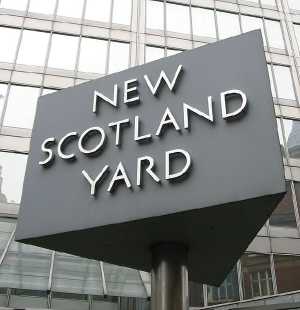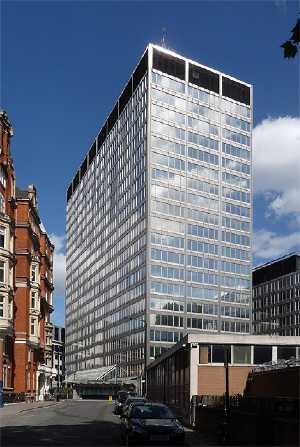 SKC Films Library SKC Films Library |
| SKC Films Library >> Sociology >> Social Pathology >> Police |
| Scotland Yard (aka New Scotland Yard or The Yard) the headquarters of the Metropolitan Police Service, which is responsible for policing Greater London (but not the City of London itself)
New Scotland Yard occupies a 20-story office block along Broadway and Victoria streets in Westminster, just a few hundred feet from the Houses of Parliament. Origins Scotland Yard was originally an area just off Whitehall, London, and took its name from the palace, dating back to the reign of Edgar, which stood on the site. Edgar gave King Kenneth of Scotland a piece of ground lying beside the new palace of Westminster for his residence, requiring him to make a yearly visit to London to pay homage for the Kingdom of Scotland. The palace built there by Kenneth remained the property of the Scottish kings, where they stayed when visiting London, but in the reign of Henry II, after the rebellion of William of Scotland in 1173-1174, it was "resumed into the King of Scotland's hands." Margaret, the widow of James IV of Scotland and sister of Henry VIII of England, appears to have been the last Scottish sovereign to have made use of the palace, living there for a considerable time after the death of her husband in 1513, but by the time Elizabeth I came to the throne it was more or less a neglected ruin. On the death of Queen Elizabeth in 1603, James VI of Scotland succeeded to the English throne as James I. With the sovereignty of the two countries vested in one and the same person, the purpose of the palace at Scotland Yard became unnecessary and the site, which had come to be known as "Scotland," was divided into two yards, known as Great Scotland Yard and Middle Scotland Yard, and was used for government buildings. Early Police Connections The first association of police with Scotland Yard appears to have been in 1662, when the first police or improvement commissioners for London and Westminster set up offices there. A further association occurred when Colonel Sir Thomas de Veil, the first of the Bow Street magistrates, had an office in Scotland Yard, where he acted as an agent for memorials to public departments before moving to Bow Street about 1735. The Metropolitan Police (aka Scotland Yard) The direct association between Scotland Yard and the Metropolitan Police started when the force was formed in 1829 by Sir Robert Peel, the Home Secretary of the time. The newly formed force was to police the area in and immediately around London -- with the exception of the City of London, with its area of just more than one square mile, which formed its own police force ten years later -- and the headquarters of the metropolitan force were at No. 4, Whitehall Place, with a police station at the rear, entered from Scotland Yard itself. Although the proper official address of the headquarters was No. 4 Whitehall Place, from the very beginning it was always referred to as Scotland Yard by the press and others.
As the work and duties of Scotland Yard increased, adjoining premises were taken over and by the early 1880's the headquarters consisted of a number of separate buildings, all of which were extremely overcrowded. Important records and papers were crammed into cupboards and piled high on landings, and the provision of a new headquarters had become a pressing necessity. It was generally agreed that the headquarters should be situated in the immediate vicinity of the Home Office and the seat of government, since the Home Secretary is directly responsible to Parliament for police matters. The only acceptable site was one on reclaimed land made available by the construction of the Thames Embankment, which was opened in 1870. The site was purchased for the sum of £25,000, in 1886. Richard Norman Shaw was entrusted with the designing of the building, which was completed in 1890. The move of all the headquarters staff to the new premises took place in December 1890, and the building was officially designated New Scotland Yard. Scotland House, the complementary building occupied by the Receiver for the Metropolitan Police District, to the south of New Scotland Yard, was added several years later, from Shaw's designs. By 1935 it had become necessary to either expand New Scotland Yard or build an entirely new complex. It was eventually decided to incorporate a new police building in the development scheme for Richmond Terrace, Westminster, and a site extending northward from New Scotland Yard was agreed upon. W. Curtis Green was chosen to design the new extension, which was completed, after delays caused by World War II, in 1945. By mid-century the new building housed the immense telephone switchboard of Scotland Yard, the information room with its emergency 999 service, the forensic science laboratory, the criminal record office, the fingerprint and photography departments, and several other branches of the criminal investigation department. With the completion of the northern extension it became necessary to rename the buildings at the headquarters. The new building was designated New Scotland Yard North, the original building became New Scotland Yard Central, and Scotland House became New Scotland Yard South. Organization When it was formed in 1829, the extent of the Metropolitan Police District was approximately 120 square miles, with an estimated population of less than 1,500,000 persons; for this area there was a police force of 1,000. In 1839 the area was extended to 699.42 square miles, and the strength of the force was increased to 3,350 for an estimated population of nearly 2,250,000. The next changes didn't come until 1947, when Scotland Yard's boundaries were extended to cover 734.88 square miles, and the size of the force was increased to 15,610, for a population of 8,391,000. Today, the Metropolitan Police Service employs 31,141 officers, 13,661 police staff, 414 traffic wardens, and 2,106 Police Community Support Officers. It currently covers an area of 620 square miles, and a population of 7,200,000. The chief administrator of Scotland Yard is the Commissioner, who is appointed by the Crown on the recommendation of the Home Secretary. Directly under the Commissioner is the Deputy Commissioner, and below them at headquarters are six main departments: Administration, Traffic, Criminal Investigation, Organization, Secretariat, and Legal. The first four of these departments are each headed by an Assistant Commissioner. Each Assistant, like the Commissioner and the Deputy Commissioner, is appointed by the Crown on the recommendation of the Home Secretary. The Commissioner, Deputy Commissioner and Assistant Commissioners are also Justices of the Peace for the counties of London, Middlesex, Surrey, Hertfordshire, Essex, Berkshire, Kent and Buckinghamshire, but their functions as justices are limited to executive police matters. The Assistant Commissioner at the head of the Administration Department is responsible for discipline, distribution and other administrative matters in the force. One of his major duties is the control of all police arrangements in connection with the many ceremonials in London. The Traffic Department deals with all traffic matters. It includes the Public Carriage Office, which licenses and controls cabs and their drivers, and the drivers and conductors of buses, coaches and trolley vehicles in the metropolitan area, as well as police transport, the Police Motor Driving School and the Lost Property Office. The Criminal Investigation Department deals with all aspects of criminal investigation, including the Criminal Record Office, fingerprint and photography sections, the Company Fraud Squad, the Flying Squad, Special Branch, the Metropolitan Police Laboratory, and the Detective Training School. The Organization Department is concerned with civil defense, supplies and equipment, first aid, buildings and housing, recruitment and training, police dogs, medical services, communications, and welfare. The Secretarial Department is under the control of the Secretary, who is not a police officer but the highest member of the civilian staff of the Metropolitan Police Force. This appointment is made by the Home Secretary on the recommendation of the Commissioner. He is in charge of the civilians employed in the structure of the force, and all its secretarial work, including its registry, pay and pensions, and the Press and Information Department. The Legal Department is headed by a solicitor, whose duty is to advise the Commissioner on all legal matters. The solicitor is appointed by the Home Secretary on the recommendation of the Commissioner, and is also the prosecuting solicitor to the metropolitan area. Commissioners The official website of Scotland Yard is www.met.police.uk. SEE ALSO |
| SKC Films Library >> Sociology >> Social Pathology
>> Police This page was last updated on September 14, 2017. |

 Building
Development
Building
Development